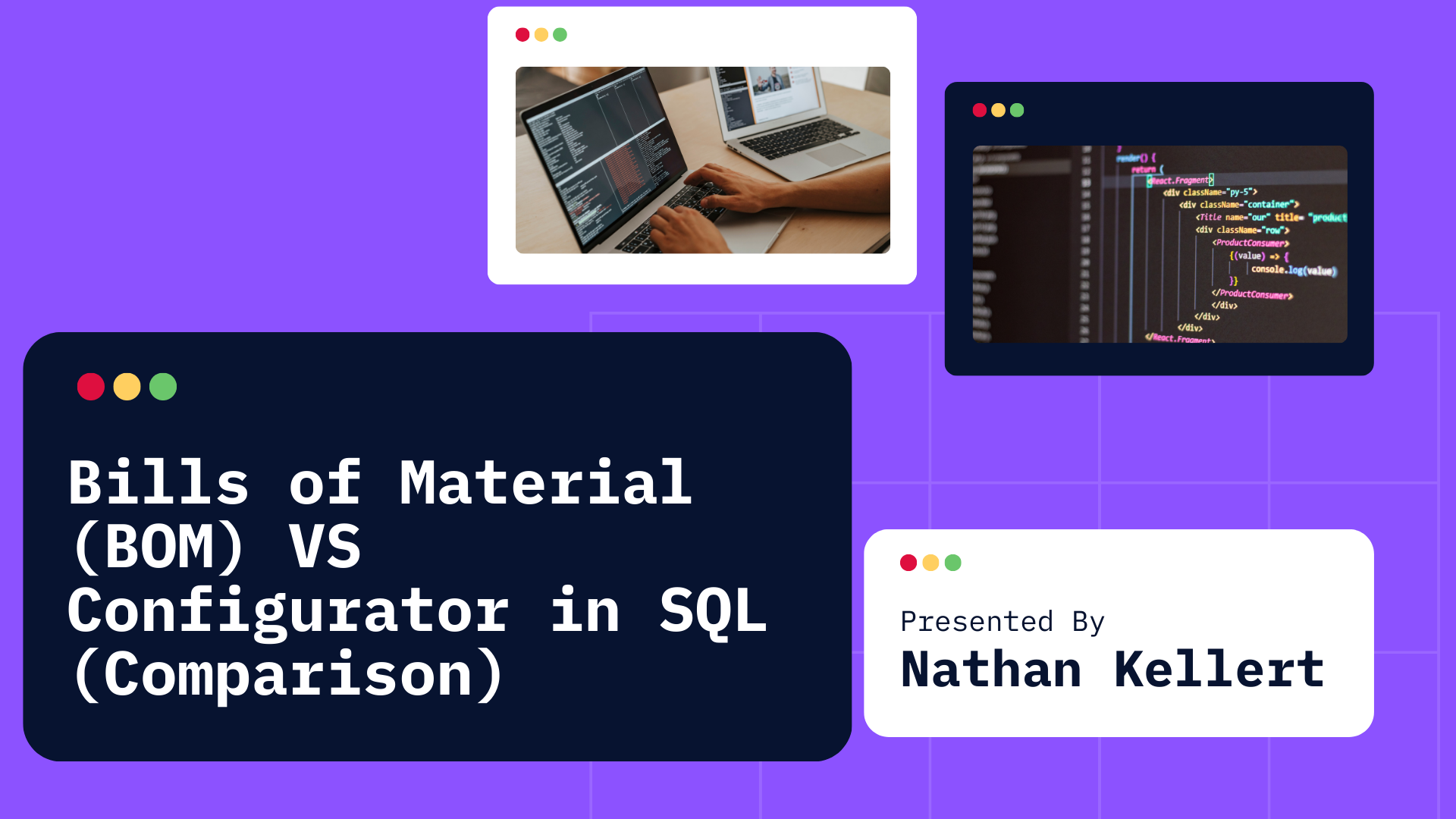
Explore the differences between Bills of Material (BOM) and Configurators in SQL databases. Bills of Materials (BOM) and Product Configurators are two essential components that help manage product structures and variations.
While they are both used to define the components or materials required to create a product, they differ significantly in their structure, purpose, and implementation, especially when it comes to SQL databases.
Understanding how to handle these two concepts in SQL is crucial for efficient product management and database design.
In this guide, we’ll explore the differences between BOMs and configurators, and how you might compare and work with them in SQL.
What is a Bill of Material (BOM)?
A Bill of Material (BOM) is a comprehensive list of all the raw materials, components, sub-assemblies, and parts required to manufacture a finished product. It includes not only the materials themselves but also the quantities needed and sometimes additional information like suppliers, part numbers, and assembly instructions.
Structure of BOM
A typical BOM can be represented in SQL using a parent-child relationship where each row represents a part or sub-assembly, and there’s a field to specify which higher-level assembly the part belongs to.
For example:
| Part_ID | Part_Name | Parent_Part_ID | Quantity |
|---|---|---|---|
| 1 | Widget A | NULL | 1 |
| 2 | Widget B | 1 | 2 |
| 3 | Widget C | 2 | 4 |
- Parent_Part_ID is used to denote which higher-level assembly the part belongs to.
- Quantity specifies how many units of the part are needed.
Example SQL for BOM Table
CREATE TABLE bom (
part_id INT PRIMARY KEY,
part_name VARCHAR(255),
parent_part_id INT,
quantity INT,
FOREIGN KEY (parent_part_id) REFERENCES bom(part_id)
);
In this setup:
- Widget A is the top-level assembly.
- Widget B and
Widget Care components ofWidget AandWidget B, respectively.
What is a Product Configurator?
A Product Configurator is a system or tool that allows customers or users to define and customize the specifications of a product based on predefined options.
It is used in scenarios where products can be highly customized, such as in the automotive or electronics industries.
A configurator helps users select different options (colors, sizes, features) to tailor the product to their needs.
Unlike a BOM, which lists the materials required for assembly, a product configurator often involves a more dynamic process, where the choices made by the user influence which components are needed for the product.
The configurator needs to dynamically calculate the final product structure based on user choices.
Structure of Product Configurator
A product configurator could be implemented using multiple tables in SQL, for example, by defining the various options available for a product:
| Option_ID | Product_ID | Option_Type | Option_Value |
|---|---|---|---|
| 1 | 101 | Color | Red |
| 2 | 101 | Size | Large |
| 3 | 102 | Color | Blue |
| 4 | 102 | Size | Small |
Each Product_ID could have multiple Option_Type (e.g., color, size, material), and each option has a specific Option_Value that is selected by the user.
Example SQL for Configurator Table
CREATE TABLE product_configurator (
option_id INT PRIMARY KEY,
product_id INT,
option_type VARCHAR(255),
option_value VARCHAR(255)
);
The product_configurator table tracks the customizable options available for each product. Based on the selections, a final product can be dynamically built.
Comparing BOM and Configurator in SQL
Although both BOMs and configurators deal with products and their components, they are fundamentally different in terms of how they are structured and used in SQL databases. Let’s break down the comparison:
| Feature | Bills of Material (BOM) | Product Configurator |
|---|---|---|
| Purpose | Defines fixed components for assembly or production. | Allows dynamic product customization. |
| Structure | Hierarchical (parent-child relationship). | Tabular (lists selectable options). |
| Flexibility | Static; usually doesn’t change once defined. | Highly dynamic; changes based on user choices. |
| Data Complexity | Simple relationships between parts and assemblies. | Complex logic to support options and configurations. |
| Database Design | Single table with parent-child relationships. | Multiple tables to handle options, values, and configurations. |
| Usage | Primarily for manufacturing and production. | Primarily for product configuration and customization. |
| Example Table | bom (Bill of Materials) | product_configurator (Product Configurator) |
How to Compare BOM and Configurator Data in SQL
While BOMs and configurators serve different purposes, they can still be compared and analyzed in SQL in certain scenarios. For example, if you wanted to see how many units of a part are used in a customized product (generated via a configurator), you could compare the data between the two tables.
Here’s an example SQL query that compares BOM data and Configurator data:
SELECT
p.product_id,
p.option_type,
p.option_value,
b.part_name,
b.quantity
FROM
product_configurator p
JOIN
bom b ON p.product_id = b.part_id
WHERE
p.product_id IN (SELECT DISTINCT product_id FROM product_configurator);
This query compares the selected options in the product configurator with the components defined in the BOM. It helps identify which parts from the BOM are required for each configured product.
Dynamic Queries for Configurators
If you need to create a dynamic SQL query to retrieve the final product structure based on user selections, you can write a query that groups all the selected options and sums up the corresponding quantities from the BOM. Here’s an example:
SELECT
p.product_id,
GROUP_CONCAT(p.option_value) AS configured_options,
SUM(b.quantity) AS total_quantity
FROM
product_configurator p
JOIN
bom b ON p.option_value = b.part_name
GROUP BY
p.product_id;
This would give you a list of products, their selected options, and the total quantity of materials needed to build the configured product.
Conclusion
BOMs and product configurators serve different roles in product management but can be compared and analyzed together, especially in systems where product configurations impact the materials and components needed for assembly. While a BOM defines a fixed set of parts, a configurator dynamically adjusts the product structure based on user input.
When designing SQL databases for these two concepts, the BOM is typically represented using a hierarchical structure, whereas the configurator is represented using tables that capture product options and user selections. By understanding these differences, you can design more effective systems for managing product data, and use SQL to compare, analyze, and optimize the product-building process.
Let me know if you need any more information on BOMs or configurators!







